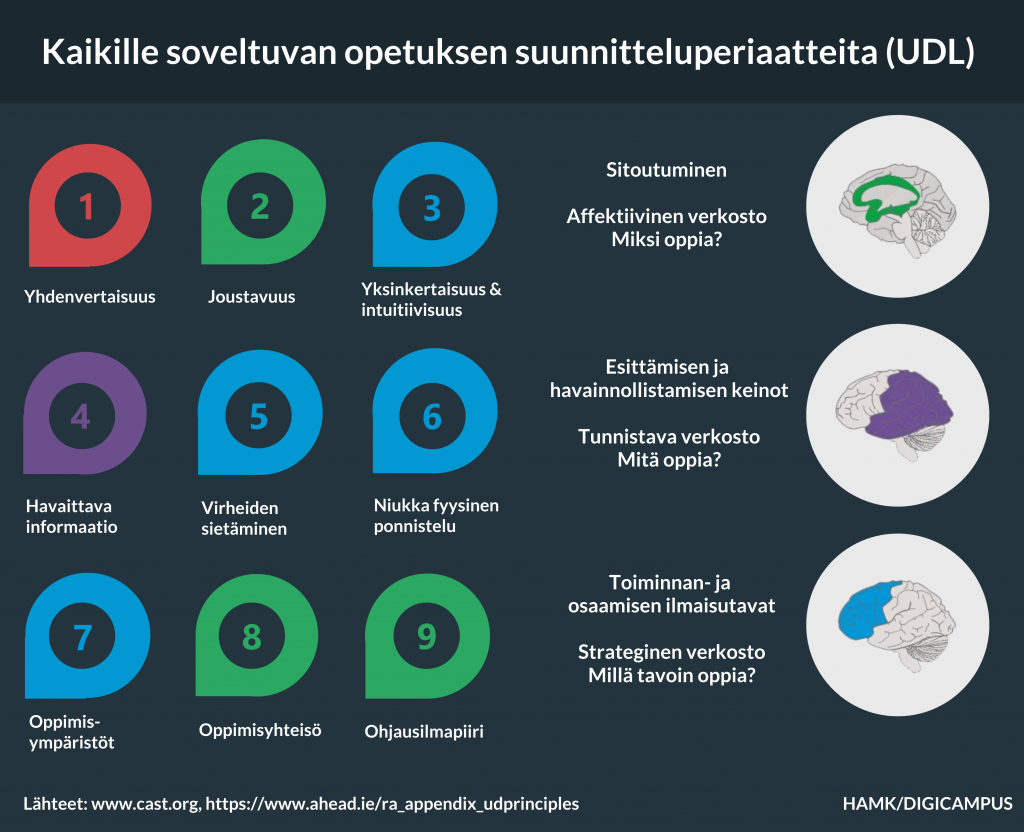UDL principles for considering different students within HAMK’s operational guidelines

Article sections
Author: Merja Saarela
Universal Design for Learning (UDL) means loosely defined teaching planning that takes into account all students. Each of us has different strengths and weaknesses in other areas of intelligence: linguistics, logical-mathematical, visuospatial, musicality, etc. Learning styles and preferences are different. Some feel that they learn best by listening, some by seeing, some by doing, and most of them make use of all of the above to some extent. The learning experience is also shaped by different life situations, linguistic and cultural backgrounds, as well as possible permanent or temporary mobility and functioning barriers that cause learning difficulties. Due to diversity, we receive, process and store information individually and for individual purposes. The best learning experiences and results are possible for the student when the lesson planner takes into account already in the planning phase:
- the potential diversity of learners,
- the construction of accessible presentation materials, learning materials, learning environments and alternative learning tasks,
- opportunities to use technology to assist learning.
The UDeL framework offers a systematic approach to design teaching to be communicatively and pedagogically accessible, so that as many students as possible have the opportunity to make the most of their own unique talent and learning potential. From the UDL point of view, diversity is taken into account through three main principles (Figure 1):
- Commitment to learning (Engagement). Individual choices of materials, working methods and tasks that support personal interest, learning profile and competence create a basis for commitment to learning throughout the entire learning process. Self-commitment strengthens the activation of the affective network in the brain – why learn.
- Presenting the learning material in several ways (Representation). By presenting information and contents in several ways, multi-channel, access to the learning material is ensured. In this case, the recognizing network is activated in the brain – what to learn.
- Various types of action and expression (Action and Expression). By providing strategic and goal-oriented students with options to express their competence in different ways, the strategic network of the brain is activated – how to learn.
In summary, it can be said that designing learning that is suitable for everyone ensures equal learning opportunities for students as well as the accessibility of learning environments and materials. Considering the diversity of learners by offering flexible options, gives the student the opportunity to make individual choices and strengthens commitment to studying. The effort is to break away from traditional, almost exclusively text-based didactics and learning materials, thereby strengthening opportunities for studying through an individual learning style. In teaching, the aim is towards dynamic, activating and inclusive practices and learning environments. At its core, the purpose of UDL is to provide consciously chosen options for all students so that they can learn to direct their own learning and work from their own individual starting points.

Listen to more from the UDeL recording (in Finnish) of HAMK’s personnel days (Kaltura instruction video, duration 29:55).
Sources
Hall, T. E., Meyer, A., & Rose, D. H., Eds. (2012). Universal design for learning in the classroom: Practical applications. New York: Guilford Press.
Nelson, L. L. (2013). Design and Deliver: Planning and Teaching Using Universal Design for Learning, Brookes Publishing.
Padden, Lisa, O’Connor, John and Barrett, Terry (Eds.). (2017). Nine Principles of Universal Design for Instruction. Universal Design for Curriculum Design: Case Studies from University College Dublin. Dublin: Access and Lifelong Learning University College Dublin.
Saarela, M. (2016). Multimodality and learning: Increasing understandability and accessibility. Article in SeOppi 2/2016. https://eoppimiskeskus.fi/en/multimodality-and-learning-increasing-understandability-and-accessibility/.
This guide was produced in the Disability and Accessibility sub-project of the DigiCampus project. The DigiCampus project is funded by the Ministry of Education and Culture, and the sub-project is implemented by Häme University of Applied Sciences, the University of Jyväskylä and Jyväskylä University of Applied Sciences.

